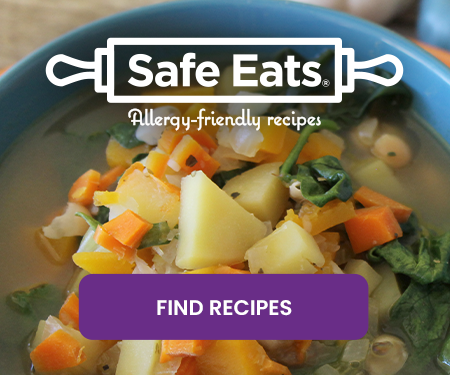Living with Food Allergies

Peanut Allergy
Peanut allergy is a common allergy among children. About 2% of children in the United States have a peanut allergy.1
A peanut allergy is an immune system reaction to peanut protein. Peanuts, which are legumes, contain many different proteins that may trigger an allergic reaction. Peanut allergy can be severe and life-threatening if not treated promptly. There is no cure for peanut allergy, but there are treatment options. Peanut allergy can impact a child’s emotional and mental health as well.
Children with a peanut allergy must avoid peanut in all forms. This includes all peanut-containing products. It is possible to lead a healthy life without peanuts. You can successfully manage peanut allergy with knowledge, support, and resources. This guide will help you manage peanut allergy with confidence.
Closed
What are the symptoms of peanut allergy?
A peanut allergy is an immunoglobulin E (IgE) mediated allergy. This means your immune system makes antibodies called IgE antibodies. These IgE antibodies react with peanut proteins and cause symptoms of an allergic reaction. This has the potential to cause a severe allergic reaction called anaphylaxis [anna-fih-LACK-sis].
When you have peanut allergy, you need to be aware of the symptoms of anaphylaxis. Symptoms of anaphylaxis may include hives, vomiting, or trouble breathing. The treatment for anaphylaxis is injectable epinephrine.
Signs and symptoms of anaphylaxis in children, teens, and adults include:
- Skin rash, itching, hives
- Swelling of the lips, tongue, or throat
- Shortness of breath, trouble breathing, wheezing
- Stomach pain, vomiting, diarrhea
- Feeling like something awful is about to happen
Common signs and symptoms of anaphylaxis in infants and toddlers include:2
- Skin rash, itching, hives
- Swelling of the lips, tongue, or throat
- Stomach pain, vomiting, diarrhea, spitting up
- Hiccups
- Arching back, bringing knees to the chest
- Coughing, wheezing
- Rubbing eyes, itchy or red eyes
How do doctors diagnose peanut allergy?
A doctor will do a physical exam and ask questions about medical history. They will ask about what happens when your child eats peanut. They will want to know how soon symptoms appeared after eating and if and how you treated it and if the treatment was effective. They may order allergy testing to help confirm the diagnosis. A skin prick test or a blood test known as a specific IgE test may be used by your doctor to help diagnose this food allergy.
Your doctor may also recommend a test called an oral food challenge. This test is done by an allergist in a medical setting that equipped to treat an allergic reaction. It is the gold standard to diagnose a food allergy or confirm if your child has outgrown the allergy. Sometimes an oral food challenge is necessary when your child’s medical history is not entirely clear. Also, a positive skin or blood test to peanut may not mean your child is allergic to peanut. In people who do not have a clear history of having a reaction to peanut, an oral food challenge is the only way to truly confirm or rule out the allergy.
How can I prevent peanut allergy reactions?
Peanut is a common ingredient that can be found in many types of food. Foods that may contain peanut protein include cereals, baked goods, candies, sauces, and more.
The only way to avoid an allergic reaction is to remove peanut from your diet. This includes all peanut products.
But you can successfully manage your peanut allergy. This can be done by:
- Working with your doctor
- Reading labels
- Being aware of cross-contact (when foods come into contact with each other and may transfer an allergen into a food that shouldn’t have it)
- Clearly communicating with school staff, people who prepare your child’s food, and babysitters and other caregivers
How do I read labels for peanut?
Under the Food Allergen Labeling and Consumer Protection Act (FALCPA), food companies must label their products clearly if they contain peanut.
When reading labels for peanut, look for peanut to be labeled either in parentheses after an ingredient in the ingredient list or in a statement under the ingredient list. For example:
- Goober peas (peanut)
- Contains: Peanut
Sometimes peanut may appear in bold print in the ingredient list too. To avoid peanut in foods and other products, it helps to learn the different names of peanut (see our list below).
Some food companies put advisory statements on their labels. They may say “may contain peanuts” or “made in a facility with peanut.” FALCPA does not require these statements. They can be confusing and may not tell you the actual risk of the product. If you have questions about advisory labels, talk with your doctor.
If a food item does not have a label, you can’t read it, or you have any doubts, don’t eat it. Always read the entire label every time. Food companies may change their recipes.
The FALCPA does not apply to all foods and everything that may contain peanut though. This means peanut could be “hidden” in products or listed under other names. Or you may not be able to find out the exact ingredients. These foods and products do not have to have peanuts clearly listed or labeled and may contain peanut:
- Arts and crafts supplies
- Prescription and over-the-counter drugs
- Cosmetics and personal care items (such as, makeup, lotions, and soaps)
- Alcohol
- Toys
- Pet or animal food
- Food served in restaurants, cafeterias, or other food service providers
There are many different names for peanut. When shopping and cooking, have a list of the different names of peanut on hand to check food packages for peanut ingredients. We have compiled a list of the different names of peanut below. You can also download and print Kids with Food Allergies’ (KFA) Guide to Managing Peanut Allergy and Chef Cards.
Most states in the U.S. do not have regulations regarding food allergies and restaurants. Ingredients in restaurant foods may vary. Cross-contact is also more likely. This occurs when a peanut-containing food comes into contact with another food that does not usually contain peanut. For example, if someone uses the same spatula to make peanut butter cookies and sugar cookies, the sugar cookies may have peanut protein in them.
Many restaurants are becoming more food allergy aware though. Look for places that have food allergy policies and allergy menus. Give the staff a chef card that alerts them to your allergy and lists peanut ingredients for them to watch for.
Peanut ingredient list
CONTAINS PEANUT
Arachic oil
Arachis
Arachis hypogaea
Artificial nuts
Beer nuts
Boiled peanuts
Cold pressed, extruded or expelled peanut oil
Crushed nuts, crushed peanuts
Earth nuts
Goober peas
Ground nuts, ground peanuts
Hydrolyzed peanut protein
Mandelonas
Mixed nuts
Monkey nuts
Nu nuts flavored nuts
Nut pieces
Nutmeat
Peanuts, peanut butter, peanut butter chips, peanut butter morsels
Peanut flour
Peanut paste
Peanut sauce, peanut syrup
Spanish peanuts
Virginia peanuts
PEANUT IS SOMETIMES FOUND IN
Artificial flavoring
Baked goods (such as cookies, cakes, and pies)
Candy
Chili
Chocolate
Crumb toppings
Egg rolls
Enchilada sauce
Ethnic foods: African, Asian, Chinese, Indian, Indonesian, Thai, Vietnamese, Mexican
Fried foods
Flavoring
Glazes
Graham cracker crust
Grains (such as Muesli cereal)
Hydrolyzed plant protein
Hydrolyzed vegetable protein
Ice cream, ice cream sundaes, parfaits
Marinades
Marzipan
Mole sauce
Natural flavoring
Nougat
Pet food
Pudding
Sauces (such as chili sauce, hot sauce, pesto, gravy, mole sauce, and salad dressing)
However, if the food regulated by the Food and Drug Administration (FDA), the word “peanut” must appear on the label.
MAY NOT BE SAFE
Lupin, lupine, lupini, lupinus albus
Lupine is a legume that cross-reacts with peanut at a high rate and may cause symptoms in some people with peanut allergy. It does not fall under the labeling requirements of FALCPA. Lupine is also known as lupinus albus and can be found in seed or flour form. Lupine is becoming more popular in gluten-free and vegan foods. If you have a peanut allergy, ask your allergist if you should avoid lupine.
 Download or Order Print Copies: “A Guide to Managing Peanut Allergy” (Includes Chef Cards and More) |
 Download or Order Print Copies: Peanut Allergy Chef Cards |
Is peanut oil safe for peanut allergy?
FALCPA does not require peanut oil to be labeled as an allergen. Studies show highly refined, distilled oils can be safely eaten by people with food allergies. For example, highly refined peanut oils contain extremely small levels of allergenic protein and can be tolerated by most people with a peanut allergy. However, peanut oil that is expeller pressed, extruded, or cold pressed does contain peanut protein and must be clearly listed on an ingredient label as “peanut.” These types of peanut oil should be avoided by people with peanut allergy.
Do I need to avoid foods related to peanut?
Cross Reactivity
Cross-reactivity occurs when the proteins in one food are similar to the proteins in another. When that happens, the body’s immune system sees them as the same.
Birch and Grass Pollen
Peanuts contain proteins that cross-react with birch (a type of tree) or grass pollen. Some (but not all) people with these pollen allergies may have pollen food allergy syndrome (PFAS) – also called oral allergy syndrome (OAS) – to peanut. And, for people who do have PFAS, they may have symptoms with some, but not all, foods cross-reactive to a particular pollen to which they are allergic.
Soy, Beans, and Other Legumes
Peanuts are in the legume family, which includes different beans, such as soybeans, other beans, and lentils. They are not the same as tree nuts. A common question that comes up for people with an allergy to peanut is whether they can eat soy-based foods or other beans. More than half of peanut-allergic individuals will have a positive skin test or blood allergy test to another legume. But it turns out that 95% of them can tolerate and eat the cross-reactive legumes. Many years ago, it was common to recommend avoidance of all legumes, including soy, because of a peanut allergy. This practice has been proven unnecessary. One possible exception is lupine/lupin.
Lupin, Lupine, Lupini
“Lupinus albus” is known as lupin, lupine or lupini and can be found in bean, seed, or flour form. Studies show that people who are allergic to peanuts appear to have a greater chance of being allergic to lupin. Lupin is a common food ingredient in Europe and it is relatively new to the U.S. market. It is likely to become more popular, particularly in gluten-free and vegan foods. For some people allergic to peanut, eating lupin could cause an allergic reaction on the first exposure. The FDA is actively monitoring complaints of lupin allergies by U.S. consumers. Find out more: Allergies to a Legume Called Lupin: What You Need to Know
Tree Nuts
Peanuts are legumes and are not botanically related to tree nuts (such as almonds, walnuts, cashews, pecan, hazelnuts, pistachio, etc.). However, it is not uncommon to have multiple food allergies. For example, someone with peanut allergy may also have a tree nut allergy.
Some doctors recommend children with an allergy to peanuts avoid all nuts. Young children may have a hard time telling the difference between a peanut and tree nut. Also, there is potential for tree nuts to have cross-contact with peanuts. (There are also plenty of sources for peanuts that are not processes with peanuts and vice versa.)
Other doctors recommend that children not avoid foods unnecessarily. Eating a variety of foods, including tree nuts, supports good nutrition and may prevent a new allergy from developing.
Each person’s allergy and dietary needs are different. Ask your allergist about tree nuts and if they should be included or avoided in your child’s diet.
What can I substitute for peanut in recipes?
There are many options to replace peanuts in recipes. You can use safe seeds, tree nuts, beans, and even grains to replace peanuts.
Learn more: Replacing Peanuts in Recipes
How can I make sure my child gets enough nutrition on peanut-free diet?
Peanuts are a good source of protein in a child’s diet. Peanuts also provide a source of niacin, magnesium, vitamins E and B6, manganese, pantothenic acid, chromium, folacin, copper and biotin. Your child can get vitamins and nutrients by consuming a variety of foods from other food groups.
| NUTRIENTS LOST WHEN AVOIDING PEANUT |
SUGGESTED ALTERNATE SOURCES (if not allergic) |
| Protein, Vitamins, Minerals | Increase other protein foods such as meat, fish, poultry, eggs, dairy (if safe for your child); fruit, vegetables, and enriched grains |
Will my child outgrow their peanut allergy?
Peanut allergy is usually life-long once acquired. Studies show that about 20% of children diagnosed with peanut allergy will outgrow it.3 (This means one out of five kids will have their peanut allergy resolve.)
Is there a treatment for peanut allergy?
Food oral immunotherapy (OIT) is a food allergy treatment that retrains your child’s immune system to respond differently to specific food allergen. OIT is not a cure for food allergies. But it may allow your child to eat a certain amount of a food without having an allergic reaction and with less stress and worry.
Palforzia is the first and only FDA-approved treatment for peanut allergy. It contains a very specific amount of peanut flour. The FDA approved it on Jan. 31, 2020. Palforzia is approved for children ages 4 to 17 who have a been diagnosed with a peanut allergy.
There are no other FDA-approved OIT treatments for other food allergens at this time. (As of December 2022.)
Many doctors have been offering OIT treatment using foods in various forms, such as a liquid, flour, or the actual food itself. These methods are not approved by the FDA. Talk with your child’s doctor about the most appropriate OIT option for your child. The FDA is looking at other food allergy treatments to fast track through the approval process to address this unmet need in the food allergy community.
There are many known side effects or possible adverse reactions to OIT. Talk with your allergist to see if this treatment might be right for your child and family.
Food Allergy Fact
Peanut and tree nut allergies tend to be life-long allergies.
Medical Review: December 2022 by John James, MD
References
1. Sicherer SH, Muñoz-Furlong A, Godbold JH, Sampson HA. US prevalence of self-reported peanut, tree nut, and sesame allergy: 11-year follow-up. J Allergy Clin Immunol. 2010 Jun;125(6):1322-6. doi: 10.1016/j.jaci.2010.03.029. Epub 2010 May 11. PMID: 20462634.
2. Pistiner, M., Mendez-Reyes, J. E., Eftekhari, S., Carver, M., Lieberman, J., Wang, J., & Camargo, C. A. (2021). Caregiver-reported presentation of severe food-induced allergic reactions in infants and toddlers. The Journal of Allergy and Clinical Immunology: In Practice, 9(1). doi.org/10.1016/j.jaip.2020.11.005
3. American College of Allergy, Asthma & Immunology. (2022, June 21). Peanut. https://acaai.org/allergies/allergic-conditions/food/peanut/
Ask the Allergist
Have a question on managing food allergies, asthma, other allergic conditions? Our allergist can help.














